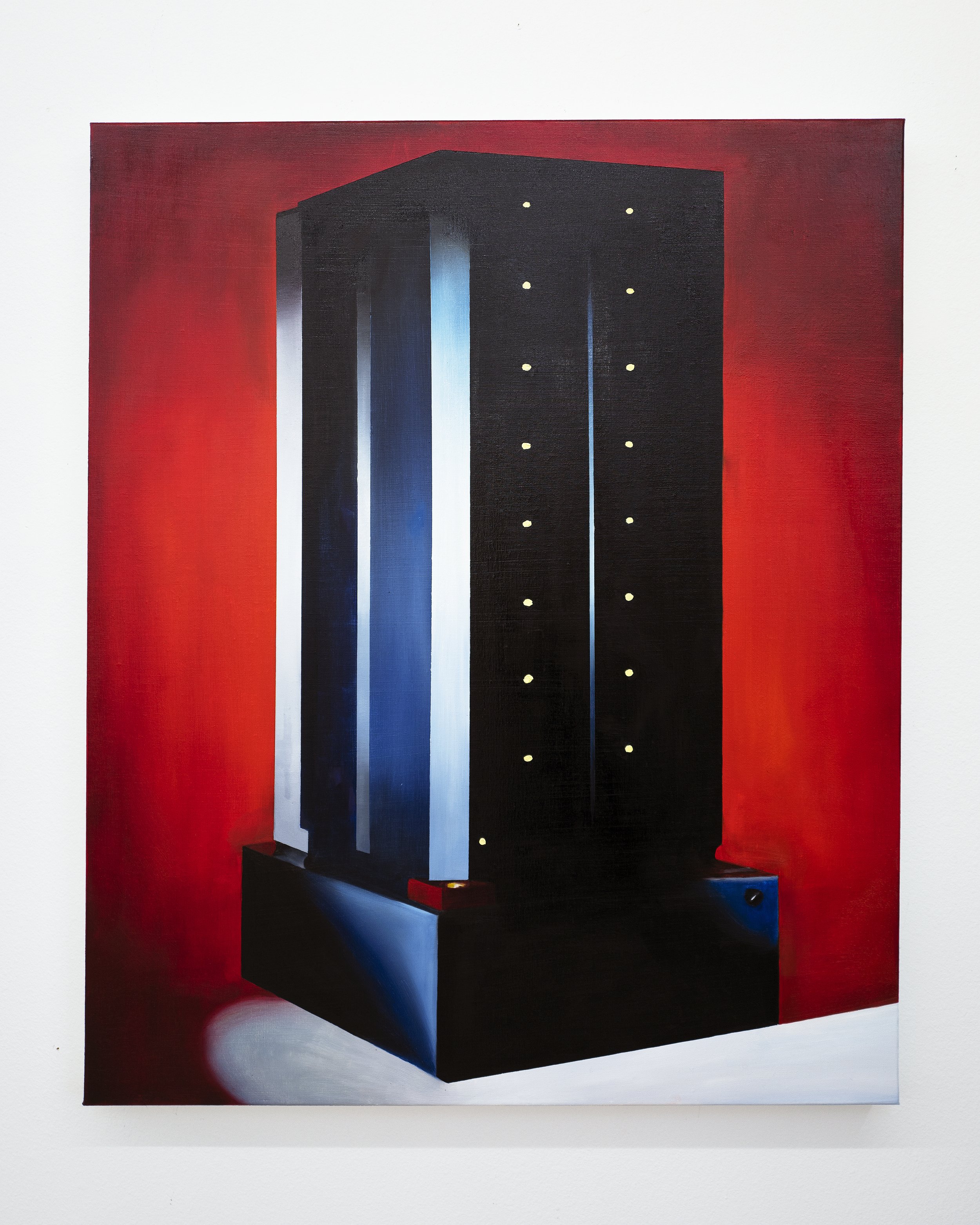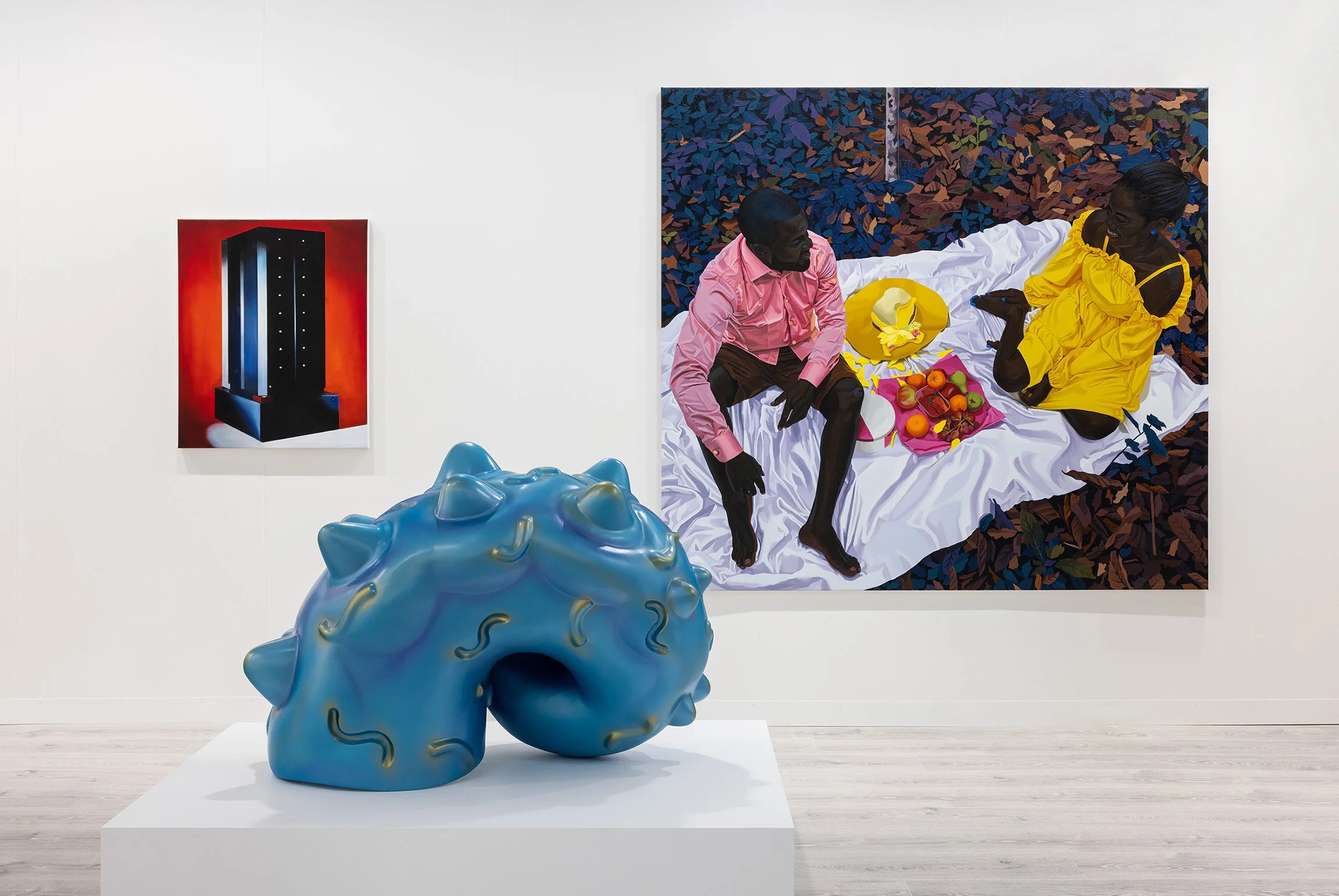Checkmate, 2022
Checkmate, 2022
Oil on linen
91 x 76 cm (36 x 30 in)
Checkmate (2022) commemorates a pivotal moment in AI history: IBM’s Deep Blue defeating world chess champion Garry Kasparov in 1997—the first time a computer triumphed over a human grandmaster in a full match. This victory stunned the world, marking the rise of artificial intelligence and its ability to surpass human intellect in a domain long seen as the pinnacle of strategic thought. Originally conceived by Feng-hsiung Hsu in 1985, the Deep Blue project gained momentum when Hsu and his team joined IBM in 1989. By the 1997 match, Deep Blue’s alpha-beta search algorithm and custom hardware allowed it to evaluate up to 200 million positions per second. This breakthrough underscored AI’s growing ability to tackle complex intellectual challenges once thought uniquely human. Checkmate captures this turning point, emphasizing the interplay between strategic reasoning and memory storage while serving as a visual testament to a historic human-machine confrontation. As AI advances, revisiting this moment gains new relevance, prompting viewers to reflect on the shifting relationship between humans and machines.
Paris+ by Art Basel, October 20 – 23, 2022, Grand Palais, Paris
Q: Why did you choose this iconic moment in the history of artificial intelligence as the theme for your work?
Tan Mu: I chose this iconic moment in AI history—the victory of Deep Blue over Garry Kasparov—as the theme for my work because it represents a pivotal juncture in the evolution of artificial intelligence and its relationship with human cognition. I’ve long been fascinated by how AI has shaped and continues to shape our understanding of intelligence. When I encountered the story of Deep Blue, I was struck by its significance: not just as a technological achievement, but as a symbolic turning point in AI's development. Chess has always been considered the ultimate intellectual battlefield for both humans and machines. Deep Blue’s victory in 1997 wasn’t just about beating a chess champion—it was about AI reaching a level where it could compete with human intellect in an arena traditionally dominated by humans. This moment marked a profound shift, suggesting that machines could eventually match or even surpass human abilities in certain domains. I’ve been reflecting on this turning point ever since, and when I created Checkmate, I did so from a perspective of “future archaeology,” reimagining and reinterpreting this historical event through art. At the time of Deep Blue’s victory, I was a child, so I came to the story with a sense of both nostalgia and wonder. Now, with the rapid pace of AI advancements—like the rise of ChatGPT and other transformative technologies—the significance of Deep Blue’s victory feels even more relevant. Checkmate has taken on new layers of meaning for me, serving as a reminder of the immense potential of human ingenuity and the profound impact technology can have on our future.
Q: How did you use visual language to depict Deep Blue, which symbolizes the confrontation between artificial intelligence and human intellect?
Tan Mu: In this painting, I used visual language to depict Deep Blue as a powerful, almost intimidating presence—representing both the machine’s intellectual capacity and the dramatic shift in human-machine interaction. The name "Deep Blue" comes from the color of the IBM supercomputer that constructed it. This system consists of many specialized chips, which are deep blue in color. When painting the device, I incorporated blue into its main body to emphasize its connection to advanced, specialized technology. The smooth, towering structure with glowing yellow dots evokes a sense of cold precision, highlighting its computational power. The stark red background intensifies the tension, contrasting sharply with the machine's black and blue, while echoing the fierce confrontation between AI and human intellect, as seen in its match against Garry Kasparov.
Q: In the context of the rapid development of AI technology today, what new significance does revisiting this historical moment hold for contemporary audiences?
Tan Mu: In the context of today’s rapidly advancing AI technology, revisiting this historical moment takes on new and deeper significance. Checkmate has, in a way, become an emotional anchor along the timeline of AI’s evolution, offering us a way to reflect on its development. Just a few decades ago, we marveled at AI’s ability to defeat a human, but now, AI has become an essential part of daily life and work for almost everyone. Recent research suggests that the cognitive processing methods of large language models (LLMs) resemble regions of the human brain specialized for tasks such as image recognition and logical analysis, presenting a "point cloud" structure that mirrors the complexity of atoms, the human brain, and cosmic nebulae. These hidden structures offer new insights into the relationship between artificial intelligence and human cognition, urging us to reconsider how AI interacts with nature and the universe itself. Looking ahead, I imagine that if we revisit this work in 10 years, its meaning will have evolved once again. This ever-shifting context reminds me that when I created this piece, I wasn’t simply making it for the present; in a way, I was creating it for the future—to be experienced by generations to come as a reflection of our current moment in AI history. The act of creating it felt like a form of "future archaeology," offering insight not just into where we are now, but into where AI might take us in the years to come.
Q: How do you view the significance of your work in documenting these groundbreaking technological moments?
Tan Mu: I see my paintings as a form of archival record, or what I would call “future archaeology”—they are not just creations of the present, but time stamps left for the future. The subjects depicted today will become material for future reflection and interpretation. By documenting current technological breakthroughs and social conditions, my art attempts to unveil the potential conflicts and challenges that may arise in the future. Although the forms of expression differ, the essence of my work aligns with those cautionary texts such as The Industrial Society and Its Future in a similar goal: to create a "prophecy" or "historical record" of the future through artistic means. For example, Checkmate not only documents the historic moment of Deep Blue's victory over a human chess champion, but also uses visual language to explore the complex relationship between artificial intelligence and human intellect.
As technology rapidly advances, the meaning of these records continues to evolve. They are not just reflections of the present, but projections of the future, becoming a visual chronicle of the technological age. Each painting serves as a time capsule, preserving the technological and societal conditions of a specific moment, while also inviting the viewer to contemplate how these breakthrough moments have shaped our future. Through this approach, I hope my work can act as a bridge connecting the past, present, and future, sparking deeper thought on the development of technology, humanity, and society.





